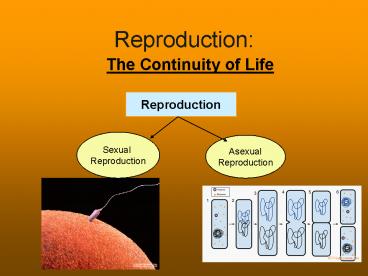Reproduction: - PowerPoint PPT Presentation
Title:
Reproduction:
Description:
Title: Sexual Reproduction Author: John Bojnowski Last modified by: EMSISD Created Date: 2/24/2006 6:07:54 PM Document presentation format: On-screen Show (4:3) – PowerPoint PPT presentation
Number of Views:59
Avg rating:3.0/5.0
Title: Reproduction:
1
Reproduction
- The Continuity of Life
Reproduction
Sexual Reproduction
Asexual Reproduction
2
Methods Advantages Disadvantages
Sexual Internal fertilization Offspring less likely to have mutations show up Successful traits can be selected and failed traits can be prevented from passing on Does require a mate to reproduce Population increases are limited
Sexual External fertilization Offspring less likely to have mutations show up Successful traits can be selected and failed traits can be prevented from passing on Does require a mate to reproduce Population increases are limited
Asexual Budding Uniformity in offspring Can increase populations rapidly Does not require a mate for reproduction to take place Lack of diversity in offspring Because they reproduce offspring genetically identical to parents, the offspring inherit any mutations of the parent.
Asexual Regeneration Uniformity in offspring Can increase populations rapidly Does not require a mate for reproduction to take place Lack of diversity in offspring Because they reproduce offspring genetically identical to parents, the offspring inherit any mutations of the parent.
Asexual Fission Uniformity in offspring Can increase populations rapidly Does not require a mate for reproduction to take place Lack of diversity in offspring Because they reproduce offspring genetically identical to parents, the offspring inherit any mutations of the parent.
Asexual Parthenogenesis Uniformity in offspring Can increase populations rapidly Does not require a mate for reproduction to take place Lack of diversity in offspring Because they reproduce offspring genetically identical to parents, the offspring inherit any mutations of the parent.
3
Asexual Reproduction Genetically Identical
Offspring
- Budding
- Regeneration
- Fission
- Fragmentation
- Vegetative Propagation
- Parthenogenesis
- Cloning???
4
Budding
- New Organisms Arise as an Outgrowth from the
Parent Organism - Seen Mostly in Marine Animals
- Examples Include Sponges, Corals and Jellyfish
Coral Polyp Photo courtesy Jeffrey N. Jeffords
http//oceanworld.tamu.edu/students/coral/coral1.
htm
5
Regeneration
- This refers to the ability of some animals to
re-grow severed parts. - Some of these animals can also grow new organisms
from the severed pieces (Segmented Worms and Sea
Stars)
6
Fission
- This is the type of reproduction all prokaryotes
go through. The DNA is copied, the cell enlarges
and splits in 2. Both cells then have the ability
to grow as large as the original cell.
7
Vegetative Propagation
- Asexual reproduction in plants when a piece of
the original plant can result in another organism
without seeds or spores.
8
Fragmentation
- When pieces of the parent organism are broken off
and grow in to genetically identical organisms.
9
Parthenogenesis
- Offspring can arise from unfertilized eggs.
- Includes some Fish, Reptiles, Amphibians and
Aphids. - Most of these species can switch between Sexual
and Asexual Reproduction. - (depending on conditions)
http//aolsearch.aol.com/aol/imageDetails?invocati
onTypeimageResultsqueryphotosofparthenogenic
speciesimg
http//www.duke.edu/7Ejsr6/Hawaiipics/Rhampho.jpg
http//spot.colorado.edu/noyesr/TEACHING/480020F
all202002.20Biology20and20Evolution20of20Sex
/Gynogenesis.Poecilia.pdf
www.ag.ndsu.nodak.edu
10
WHY???
- Why would these organisms prefer asexual
reproduction in stable conditions and sexual
reproduction in more uncertain or less favorable
conditions?
11
Imagine
- Imagine that a particular organism within a
species lacks a certain gene (or ability to
express a certain gene) necessary to break down a
specific type of food, yet others of the same
species within the population are able to break
down that food. - What happens if the uncertain or less favorable
conditions lead to that being the primary food
source?
12
Death
- The parent organism and all of their offspring
produced through parthenogenesis would die! - But, with the genetic diversity that comes from
sexual reproduction the possibility of the
offspring surviving is enhanced.































